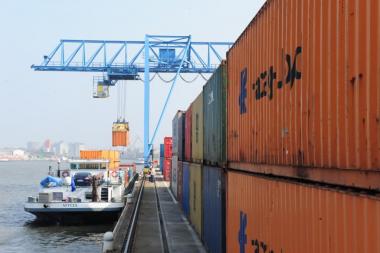
2021.01.29 - Despite the exceptional circumstances of 2020, marked by an unprecedented public health crisis, the Port of Brussels has recorded its third-best year in terms of non-transit traffic since its creation as a regional company in 1993.
While waterway transport experienced a significant decline in almost all European countries due to the economic slowdown caused by the public health crisis, overall traffic at the Port of Brussels saw a slight increase of 0.3% in 2020. This was due to the recovery of transit traffic, which experienced a significant drop in 2019, but bounced back in 2020 with an increase of more than 20%.
Despite 4.9 million tonnes of transhipments, non-transit traffic fell by 5.3%. However, this represents a strong performance, given that the lockdown in the first quarter of 2020 put a significant brake on port activity that cut non-transit traffic by as much as 32% in April. Only the years 2018 and 2019 saw figures in excess of 5 million tonnes for transported goods.
Yassine Akki, President of the Port of Brussels, stated that ‘the completely unprecedented year we had in 2020 has certainly demonstrated the resilience of port activity in Brussels and its ability to adapt to unexpected circumstances.The Port of Brussels has thus confirmed its key role in ensuring sustainable supplies for the capital, and is increasingly a major player in economic development and employment, transport and the environment.’
Commitment to climate transition
The Port’s commitment to climate transition for the Brussels Region delighted the Minister for Climate Transition and the Environment, Alain Maron: ‘We’re working on the redeployment of freight by rail to the outer harbour. This multimodal connection between rail and waterway will make the Port more attractive and strengthen supply chains at European level while reducing our carbon footprint.’
This use of water transport has very clear consequences, keeping some 621,000 trucks off the roads and saving 96,000 tonnes of CO2 and 24 million euros of external costs.
Public health crisis boosts certain categories
Despite the drop in construction materials traffic (following the total cessation of activities on construction sites during the spring 2020 lockdown) and petroleum products (a direct consequence of the reduction in travel during the same period), as usual construction materials followed by petroleum products and containers remained at the top of the product categories traded by water in Brussels.
The resumption of traffic in the second half of the year limited the losses relating to container transport, which had been estimated at 10% at mid-year. Despite a slight decrease, 2020 was the second best year for container activity since it was developed at the Port of Brussels. In terms of TEU (twenty-foot equivalent units), the loss was 5%.
The strongest performance in 2020 was in waterway transport of pallets, which saw a 33% volume increase compared to 2019, and of food and agricultural products, as a result of intense buying during the first lockdown.
The Netherlands remains the leading commercial partner of the port of Brussels, in the lead, followed by Belgium, Germany and France.
More information: www.port.brussels
















